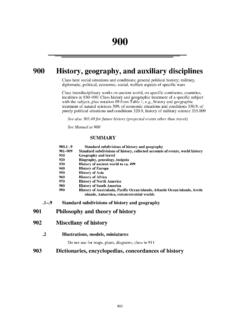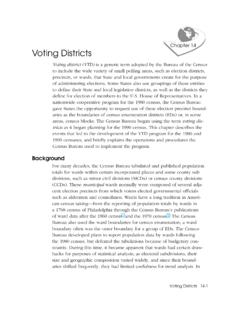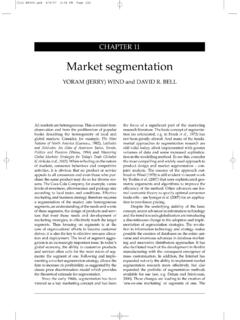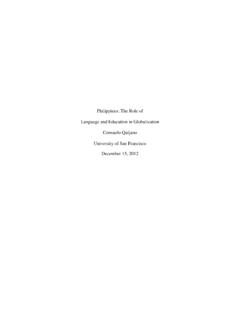Transcription of Using the Precede-proceed model - Community Tool Box
1 Using THE precede - PROCEED model . Claudine Matlo September 24 2012. Outline 1. Introduction 2. Defining the PROCEDE-PRECEED model 3. 2 visual examples of program planning 4. The steps of the PROCEDE-PRECEED model 5. Case studies Introduction This chapter emphasizes the application of behaviors change theory to program planning. The Precede-proceed model is used both for delivery programs in practice settings and when conducting behavior change interventions. The model offers a framework within which individual level theories, Community level theories, interpersonal communication, interactive technologies media campaigns and grass roots organizing can be utilized.
2 Introduction: The Precede-proceed model is a tool for designing, implementing, and evaluating health behavior change programs. Originally Developed in the 1970's by Green and colleagues When a problem affecting a particular population has been identified health, and the health professional must do something to fix the problem a planning model like PRECEDEPROCEED, which has been the cornerstone of health promotion practice for more than three decades, can help guide this process.' (p. 408). precede - Predisposing precede based on the premise that just as a medical diagnosis precedes a treatment, so Reinforcing should an educational diagnosis precede an Enabling intervention plan.
3 Constructs In Criticism was that there was too much emphasis on implementing programs and too Educational / Environmental little on designing interventions to Diagnosis strategically meet needs. Evaluation PROCEED. Policy PROCEED - was added in 1991 to recognize Regulatory environmental factors as determinants of Organizational health and health behavior. Constructs Educational Lifestyle (Environment) recognition of impact, behaviors sometimes being Environmental influenced outside of the individual media Development campaigns for health' medications. Overview of the model In 2005 the model was revised again to reflect the growing interest in ecological and participatory approaches Through these additions there is recognition of genetic factors The model can be thought of as a road map And specific behavior change theories as directions to the destination The map provides all possible avenues, and the theories help us to choose which avenue.
4 Purpose is not to predict or explain but to give a structure to applying theories in a systematic fashion for planning and evaluating health behavior change programs. The new' version . Is a streamlined, more efficient planning model . 1. merges two phases Epidemiological assessment & Behavioral +. Environmental assessment 2. provides options for skipping phases when appropriate evidence already exists the use of secondary data What has stayed the same is the emphasis on the fundamental principle of participation which states that success in achieving change is enhanced by the active participation of the intended audience ' (p. 409). Causal and action Causal Theory seeks to identify the determinants of an outcome Action theory explain how interventions affect the determinants and outcomes.
5 Causal + Action = program theory depicted as logic models PROCEDE-PRECEED is a form of a logic model Assessment, intervention planning and evaluation into one framework or model Logic model example Precede-proceed Framework Precede-proceed Framework (L. Green). precede . _____. Phase 5 Phase 4 Phase 3 Phase 2 Phase 1. Administrative Educational and Behavioural and Epidemiologic Social Policy Assessment Ecological Environmental Assessment Assessment Assessment Assessment HEALTH Predisposing PROMOTION factors Health education Reinforcing Behaviour and lifestyle factors Health Quality of Policy, Life Regulation, Organization Enabling Environment factors Phase 6 Phase 7 Phase 8 Phase 9.
6 Implementation Process Impact Outcome Evaluation evaluation evaluation _____. PROCEED. PHASE 1: Social Assessment, participatory planning, and solution analysis The SOCIAL ASSESMENT expands the understanding of people through both objective and subjective sources of information . With the goal of the common good. Understanding the Community (a geographic area or groups with shared characteristics, could also be a virtual Community ) though multiple data collection activities Interviews, surveys, focus groups, observation The social assessment articulates the communities needs and desires while considering the communities problem solving capacity, strengths, and resources, and the readiness to change, The focus is on strengths and gaps and seeking to establish partnerships with the goal of increased commitment to the program.
7 HOW? Planning committees, Community forums, conducting focus groups, concept mapping Theory and Phase 1. Community organizing theories and principles are relevant Working with Community groups to identify common problems, goals, mobilize resources, develop and implement strategies Ex the Tenderloin project with low-income older adults (TSOP, Minkler, 1983). Example of Community mobilization not as process' focused; but Community driven, involves members in problem identification, needs assessment, and program design. Phase 2: Epidemiological, Behavioral, and Environmental Assessments Identify the health priorities and their behavioral and environmental determinants.
8 Epidemiological Assessment . 1. Identify health problems, issues or aspirations on which the program will focus . 2. Uncover behavioral and environmental factors most likely to influence identified priority health concerns 3. Translate those priorities into measurable objectives Occasionally secondary data analysis is done Using existing data sources such as vital statistics, and other data bases including National health information center and Canadian Communities Health Survey (CCHS). Phase 2 cont. The use of genetics Can be helpful to identify high risk groups for intervention Gielen et al. use the example of families with breast cancer history. Other examples we can think of?
9 Behavioral Determinants These can be understood on 3 levels A. Most proximal behaviors or lifestyles that contribute to severity of a health problem teen smokers tobacco use; Cardiac patient's poor diet B. More distal determinant behavior of others that can impact the behavior of those at risk, teen smokers parents keeping cigarettes in the house, spouse of cardiac patient buying bacon. C. Most distal factor action of discoing makers that may affect the social or physical environment influencing the individual at risk, action by police in enforcing laws that restrict teen smoking; food served at a seniors center or hospital. Phase 2 Environmental Determinants Social and physical factors external to the individual often beyond their control, that can be modified to support the behavior or influence the health outcome.
10 This stage requires strategies other than education. Ex poor nutrition among school age children: - Most proximal poor dietary habits Affected by availability of unhealthy foods in school - Most distal school policies around foods served/avl in schools Older adult example? Theory & Phase 2. Through the use of theory, literature, and planning groups input, an inventory of behavioral and environmental influencing factors should be made. Useful theories include: Interpersonal theories of behavior change emphasize interaction between individual and environment ex Social Cognitive Theory . behavior, cognition, and other personal factors have a reciprocal relationship with the environment; behavior can be influenced by observing others and receiving reinforcement Peer to peer programs Organizational Change theories useful when policies or practices of formal organizations have been identified as needing change.






